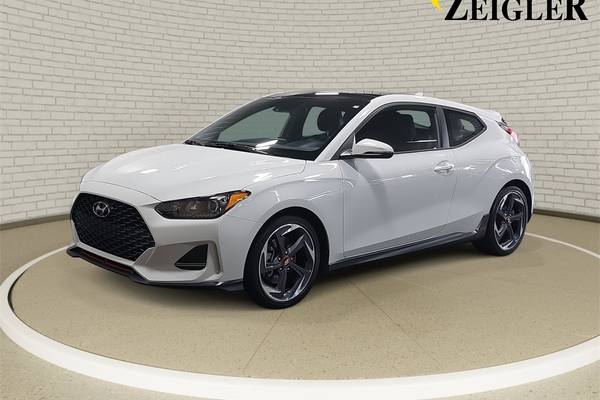2019 Hyundai Veloster Review
Price Range: $15,380 - $20,590
 View 389 more photos
View 389 more photos View 389 more photos
View 389 more photos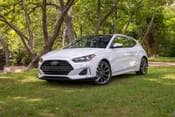 View 389 more photos
View 389 more photos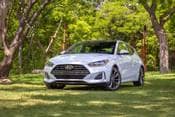 View 389 more photos
View 389 more photos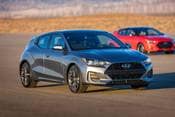 View 389 more photos
View 389 more photos+385
Edmunds' Expert Review
by Calvin Kim
Pros
- Unique and functional three-door body style
- Enjoyable power from the Veloster's turbocharged engine
- Sporty handling around turns
Cons
- Base engine is down on power
- Less trims and option packages mean fewer choices
- No power seat adjustments
What's new
- New exterior and interior design
- New 2.0-liter inline-four base engine
- Revised suspension for better handling
- Part of the second Veloster generation introduced for 2019
The 2019 Hyundai Veloster is fully redesigned. Hyundai made a variety of subtle changes to improve it compared to the first-generation Veloster, yet the car's signature design element continues to be its unique door configuration. Instead of being just another compact two-door hatchback, the Veloster has a single driver-side door and two passenger-side doors. That extra door makes carrying a third, or even fourth, passenger a piece of cake because there's no need for the contortions a typical passenger must go through in order to get into the rear seat of a coupe.
For sale near Des Moines, IA
22 listings
- $17,500fair price$154 above market
- 32,874 miles
- No accidents, 1 owner, personal use only
- 28 City / 34 Hwy MPG
- Zeigler Hyundai of Holland (391 mi away)
- Back-up camera
- Bluetooth
- Sunroof/Moonroof
- Keyless Entry/Start
- Upgraded Headlights
Close
Located in Holland, MI
Odometer is 22419 miles below market average!For A Great Experience is how we do business and promise to give you are best every day. Call (616)396-0...
AutoCheck Vehicle History Summary
Accident Free Vehicle: Yes
Personal Use Only: Yes
History Provider: AutoCheck
Title Details: Clean Title
Salvage Vehicle: No
Frame Damage: No
Theft History: No
Lemon Status: No
Free History Report: No
Features and Specs:
30 Combined MPG (28 City/34 Highway)
Listing Information:
VIN: KMHTH6AB3KU008383
Stock: KU008383
Certified Pre-Owned: No
Listed since: 06-12-2025 - 54,068 miles
- No accidents, 2 owners, personal use only
- 27 City / 34 Hwy MPG
- Carvana - Indianapolis (406 mi away)
- Home delivery*
- Back-up camera
- Bluetooth
- Tire Pressure Warnin...
- USB Inputs
- Apple Carplay/Androi...
Close
Located in Indianapolis, IN
At Carvana, we go miles beyond the extra mile. That's why we provide you with a convenient, fast, and hassle-free car buying experience that puts you ...
AutoCheck Vehicle History Summary
Accident Free Vehicle: Yes
Personal Use Only: Yes
History Provider: AutoCheck
Title Details: Clean Title
Salvage Vehicle: No
Frame Damage: No
Theft History: No
Lemon Status: No
Free History Report: No
Features and Specs:
30 Combined MPG (27 City/34 Highway)
Listing Information:
VIN: KMHTG6AFXKU017877
Stock: 2003790877
Certified Pre-Owned: No
Listed since: 06-16-2025
Power from either of the two mainstream available engines won't win any horsepower awards, but the turbocharged 1.6-liter four-cylinder engine (201 hp, 195 lb-ft) is plenty sporty for this lightweight car. The new base engine, a 2.0-liter four-cylinder, produces 147 hp and 132 lb-ft of torque. It's enough to get the Veloster moving, but that's about it.
There is, however, an added performance variant this year: the 2019 Veloster N. The N is similar to the Turbo R-Spec, but the N moniker speaks to loftier ambitions: racetrack durability in a car you drive every day. The transformation involves the usual upgrades — more power, firmer suspension, stickier tires and bigger brakes. The N's turbo 2.0-liter engine cranks out 250 hp, or 275 hp when equipped with the optional Performance pack.
On the technology side, the new Veloster gets lane keeping assist, forward collision mitigation, and Apple CarPlay and Android Auto as standard equipment. Some optional equipment on higher-trim vehicles include an 8-inch infotainment display, an Infinity eight-speaker audio system, automatic climate control, and wireless charging pad.
Overall, the 2019 Veloster fills a niche as a sporty and usable hatchback with good in-car technology and usability. Compared to the last Veloster, it's a more cohesive and comfortable car that performs better. Other compact hatchbacks, such as the Honda Civic and the Kia Forte5, feature more interior volume with similar levels of handling. But nothing else on the road offers the Veloster's unique three-door configuration.
Edmunds' Expert Rating
8.3 / 10The 2019 Hyundai Veloster is a sporty hatchback coupe that offers a little extra functionality thanks to its unique three-door configuration. But the sportiness only applies if you get the turbocharged 1.6-liter engine. The 2.0-liter engine is underwhelming and doesn't have any efficiency benefit.
Trim tested
Each vehicle typically comes in multiple versions that are fundamentally similar. The ratings in this review are based on our full test of the Hyundai Veloster R-Spec (turbo 1.6L inline-4 | 6-speed manual | FWD).
 Scorecard
Scorecard
| Overall | 8.3 / 10 |
| Driving | 9.0 |
| Comfort | 7.0 |
| Interior | 8.0 |
| Utility | 8.0 |
| Technology | 8.0 |
Driving
9.0The Veloster, especially the R-Spec, captures the spirit of small, light, front-wheel-drive sport compacts. It's an all-around fun-to-drive car, with approachable handling and just enough steering feel. Both the automatic and manual transmissions work OK, but each has quirks that slightly diminish this otherwise excellent hatchback.
Acceleration
9.5Power from the 1.6-liter turbo comes on quickly around 3,000 rpm, with no real lag, and holds until within 700 rpm of the redline. There's enough torque down low for city driving. The engine's strength through the midrange makes it fun to rev. With the automatic, the Veloster Turbo managed 0-60 mph in a quick 6.3 seconds in Edmunds testing. We also tested a car with the manual. The accel time increased to 7.2 seconds, in part because of how the clutch engages.
Braking
9.0The Veloster's brakes start off soft initially but firm up and provide more feel as pressure increases, making them easy to modulate and pleasing to use. The R-Spec managed a superb 60-0 mph braking distance of 108 feet in Edmunds testing, due in part to the sticky summer tires it comes with. We've also tested a Veloster with the all-seasons; we observed a stop of 122 feet, which is average for the class.
Steering
8.5The steering is precise but a bit light in Normal mode. In Sport, the weighting matches the car's character, and resistance builds naturally through turns. There's just enough feel from the tires to give you extra confidence and add to the fun. The on-center feel is a little numb, but enough that freeway cruising isn't a chore.
Handling
9.5The Veloster is a fun little car: There's only the slightest body roll, and it's well controlled during transitions. Turn-in is light and the car is eager to change direction. Grip from the R-Spec's sticky tires is phenomenal. Overall, the Veloster is engaging and predictable on the road, encouraging you to have a good time.
Drivability
7.0The automatic transmission behaves as you'd expect in both Normal and Sport modes, and it responds quickly to manual input from the paddles. Unfortunately, shifts — especially downshifts — can take noticeably longer to engage than we'd like. With the manual, the shifter action is a bit rubbery during travel. The clutch pedal feels a little mushy, and there's a restrictor that slows engagement.
Comfort
7.0The Veloster is sportier than most compact cars, but it's comfortable, if a bit basic. The ride is composed and stable, the seats pleasantly supportive, and the classic climate control is easy to use. We do wish the manual seats had adjustable lumbar.
Seat comfort
7.5The R-Spec's seats are nicely shaped and have a pleasantly soft but grippy cloth covering and an appropriate amount of bolstering. There's a good range of adjustability, but the seats lack adjustable lumbar, which will limit comfortable seat time for some drivers.
Ride comfort
7.0The Veloster is very settled and doesn't wallow when driving over bumps. But the ride is undeniably sporty and on the stiff side. The suspension both takes the edge off larger bumps and irons out cracks and smaller imperfections, but the short wheelbase makes the car more sensitive to choppy roads.
Noise & vibration
6.5Cabin noise is middle-of-the-road for the class. Road and wind noise shows up at freeway speeds. The engine note is persistent, which can become a little wearying on longer freeway drives. Depending on which tires you have, tire noise can become increasingly intrusive.
Climate control
7.0In lower-trim Velosters, you control the climate system through a classic two-dial control that has clearly marked buttons. It doesn't get more straightforward than this. Higher trims have single-zone climate control, which is also easy to use and highly functional. But some competitors have dual-zone at this price.
Interior
8.0The interior is intelligently designed and packaged. Even though the Veloster is small, it makes good use of the available space and its asymmetrical door design. The back seat is even usable by adults of about average size or smaller. But the long driver's door can be awkward in tight spaces, and the rear roof pillars obstruct some visibility.
Ease of use
9.0The controls are clearly marked and logically grouped, and both the trip computer and infotainment system are straightforward to learn. There's not a lot going on in this car, but what's there is easy to find and simple to use.
Getting in/getting out
7.0The long driver's side door and relatively forward position of the seat can make getting in and out of the car tough in tight parking spaces. But if you have space to swing the door wide, it's a breeze to get in for such a low car. The short passenger-side doors can open wide even with limited space, making access much easier. Getting into the rear seat requires ducking under the sloping roof.
Driving position
8.5The driving position is appropriately low and sporty, making you feel nicely ensconced. There's also a good amount of steering wheel telescope, although the shifter is a bit far forward on the console. Taller drivers might feel like they have to sit a little farther forward than they'd prefer.
Roominess
7.0Room up front is generous, with plenty of knee and shoulder room. The back seat has more room than you might think, and adults of average size or smaller should fit fine. Kneeroom is good for how small the car is. But headroom is a limiting factor, and there's very little toe room under the seatbacks.
Visibility
8.0The roof pillars are relatively thick, but the Veloster still provides a clear view forward. Rear visibility is also good, but the massive rear pillars create large blind spots in the rear three-quarters view. The wide mirrors and a good camera help a lot.
Quality
8.0There's a lot of hard plastic around the interior, but most touchpoints use nicer materials. A good variety of textures and colors liven up the cabin. The car feels solid and substantial, with tight panel construction and tolerances for the class.
Utility
8.0For such a small vehicle, the Veloster has excellent utility. The trunk is surprisingly spacious. However, it relies on a low load floor to create space, which makes for a noticeable liftover. There's also lots of interior storage. The Veloster might not be the best pick if you're frequently installing and removing a car seat.
Small-item storage
8.5The door pockets are a bit shallow, but they are wide and can hold water bottles. You also get anti-tip cupholders, a generous cubby in the center stack, and a sizable center armrest box. Rear passengers get cupholders and a small tray but no seatback pockets.
Cargo space
7.0The trunk is surprisingly generous for the car's small footprint, with 19.9 cubic feet of volume. But a lot of that volume is height. The load floor is very low, which means there's a lot of liftover — heavy items will be more awkward to load and unload. The rear seats fold down but not fully flat.
Child safety seat accommodation
6.0LATCH anchors are clearly marked but are just tucked between cushions without any special access. Top tethers are on the trunk floor, so setting up a seat means getting in the trunk, which impinges on trunk space.
Technology
8.0Our manual-transmission R-Spec test car was about as stripped-down as the Veloster gets, but it had Hyundai's very functional infotainment with smartphone connectivity and a very good stereo system. Fully loaded, the Veloster comes with nearly every feature in the book.
Audio & navigation
8.0The Infinity-branded stereo system is very good for the class. There's decent clarity and plenty of bass response, with no distortion or harshness as the volume rises. Hyundai's navigation system is basic but clear and easy to use, but it's only available on the Turbo Ultimate trim.
Smartphone integration
9.0Apple CarPlay and Android Auto are standard, and they work as you'd expect. A 12-volt plug, auxiliary jack, and both a USB data and a USB charging port are standard, and some trims come with a wireless charging pad. Hyundai also offers a connected app for remote functions.
Driver aids
6.5The base car gets a handful of aids, including lane-keeping and collision warning. Midtrim Velosters come with blind-spot monitoring and rear cross-traffic alert, but only the Turbo Ultimate gets adaptive cruise. Adaptive cruise can't take the car to a full stop, which is becoming a more common feature. We also had some issues with automatic emergency braking panicking and stopping more than a car length short of cars ahead, even when the driver attempted to intervene.
Voice control
8.0Voice controls are limited to a handful of functions, but they respond well. A guide is displayed on the infotainment screen, and it adjusts a bit to your commonly used commands. Thankfully for some commands you can skip superfluous steps and just say what you want.
Which Veloster does Edmunds recommend?
If you're looking at the Veloster, we're assuming you're exploring the sportier end of the hatchback spectrum. For that role, we recommend the R-Spec due to its turbocharged engine, sport-tuned suspension and standard summer performance tires. All are standout features in the class.
Compare 2019 Hyundai Veloster trim levels
Helpful trims summary and side-by-side comparison chart
2019 Hyundai Veloster models
The 2019 Hyundai Veloster is a three-door hatchback that seats four people. It is available in six trims. The base 2.0 model is well-equipped on tech features, while the next-up 2.0 Premium adds some luxury features. Both are powered by a 2.0-liter inline-four (147 hp, 132 lb-ft). The next three trims are powered by a turbocharged 1.6-liter inline-four (201 hp, 195 lb-ft).
The Turbo R-Spec adds performance features while keeping it simple. The Turbo adds safety and luxury features, while the Turbo Ultimate combines the best from both and adds even more luxury amenities. Headlining the lineup is the Veloster N with its upgraded engine and performance parts.
The 2.0 model is the only Veloster variant that rides on 17-inch wheels. It comes with a six-speed manual transmission as standard, but it can be optioned with a six-speed automatic. Since the 2.0 is the base car, all its features are standard on every other variant. These features include safety features such as a forward collision mitigation system, lane keeping assist and a rearview camera. The 7-inch infotainment system features standard Apple CarPlay and Android Auto connectivity, Bluetooth, two USB ports and a six-speaker sound system.
Premium models add 18-inch wheels and come with the six-speed automatic transmission as standard. Also standard is additional safety equipment such as blind-spot monitoring with rear cross-traffic alert. In addition, standard luxury equipment includes a sunroof, automatic climate control, heated front seats, and a proximity entry system with push-button start. The infotainment system gets a boost as well thanks to an 8-inch display, Hyundai's Blue Link connected services, a standard wireless charging pad, and an eight-speaker Infinity audio system with satellite radio.
The Turbo R-Spec is our favorite of the line. It has the turbocharged engine, a standard six-speed manual transmission (the automatic isn't offered here), summer performance tires and a sport-tuned suspension. R-Spec equipment includes much of what you get with the 2.0 with bits of Premium intermixed throughout, such as the infotainment system, Blue Link connectivity, and the proximity entry system and push-button start. R-Spec specific items include LED headlights with high-beam assist, LED taillights and its own cloth seat design.
For the Veloster Turbo, Hyundai essentially takes the Premium and adds the turbocharged engine, the seven-speed dual-clutch automatic transmission and special interior trim. The Turbo Ultimate reverts back to a standard six-speed manual transmission, with the dual-clutch transmission as an option. It also comes with some luxury equipment, such as leather seating surfaces, a head-up display and a built-in navigation system. Also included is additional safety equipment encompassing a forward collision mitigation system that features pedestrian detection, automatic wipers, and adaptive cruise control for automatic transmission-equipped cars.
For the N, Hyundai drops in a turbocharged 2.0-liter engine good for 250 hp and 260 lb-ft of torque. It also comes with a six-speed manual transmission, a reinforced body structure, N-specific suspension tuning with adaptive dampers, performance brakes, 18-inch wheels with stickier tires, a rear wing, special red accents and sport front seats. An optional Performance package for the N adds a limited-slip front differential, a variable exhaust, 19-inch wheels, even bigger brakes and an extra 25 hp.

2025 Toyota Highlander Hybrid vs. Hyundai Santa Fe Hybrid: Which Three-Row SUV Should You Buy?
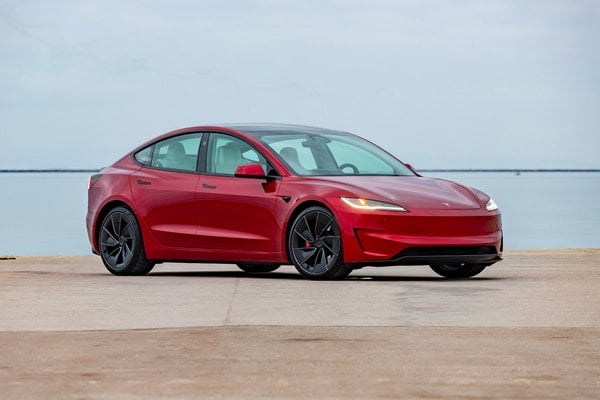
Our 2024 Tesla Model 3 Performance Is an Edmunds U-Drags Assassin
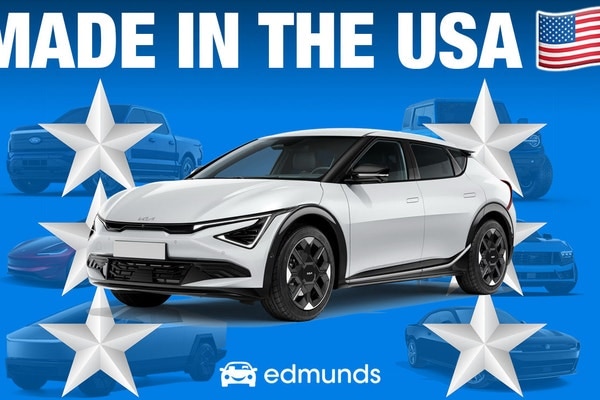
The Best Cars (Currently) Made in America

Is Our 2024 Hyundai Santa Fe Hybrid Delivering Luxury on a Budget?
Cost to Drive
Monthly estimates based on costs in Iowa
$130/mo for Veloster 2.0
Veloster 2.0
vs
$157/mo
Avg. Compact Car
See Edmunds pricing data
Has Your Car's Value Changed?
Used car values are constantly changing. Edmunds lets you track your vehicle's value over time so you can decide when to sell or trade in.

Reliability Ratings by RepairPal
4 out of 5 stars4/5Above Average
#30 out of 46 among Compact Cars
RepairPal Reliability Ratings are based on the actual cost, frequency, and severity of unscheduled repairs and maintenance on make/model data for select 2008-2022 vehicles. The reliability of a specific vehicle may vary depending on its maintenance and driving history, model year, trim, and features.
Cost
$477/yr
vs. $416/yr
for Average Compact Car
for Average Compact Car
Frequency
0.97x/yr
vs. 1.01x/yr
for Average Compact Car
for Average Compact Car
Severity
14.1%
vs. 10.4%
for Average Compact Car
for Average Compact Car
powered by RepairPal
Hyundai Veloster Owner Reviews
Most Helpful Owner Reviews
Trending topics
Exactly what I wanted
5 out of 5 starsRon Fox, 10/15/2018
2019 Hyundai Veloster Turbo 3dr Hatchback (1.6L 4cyl Turbo 7AM)
This car gets left out of a lot of interesting comparisons for some reason. Maybe it's because Hyundai hasn't had the reputation like some of the other manufacturers, or because the third door puts it in between a sedan and a coupe. It doesn't matter, this is a really great car that I'm guessing most people won't find. I chose it over the Mazda 3 because for the same price, it had far … more options, was more efficient and had way more pop on the throttle. I also felt that the interior quality was much higher particularly at the the joints and seams of the trim. The warranty was also out of this world. Actual driving usage puts this car much higher than EPA estimate MPG ratings. I routinely get 39mpg in mixed traffic on normal driving mode. Smart (eco) sees even higher efficiency numbers at the expense of acceleration. Sport mode is just a blast. I do not fully understand how to drive this car with the paddle shifters, however. This car is my commuter and provides great comfort for me (a larger guy) and enough room to comfortably fit (and access) a child seat in the back for morning school drop off. All of the doors shut with a very solid, sealing, "thunk" akin to german car manufacture and quality. The Inifinity stereo system is perfect in this car with a high degree of clarity across multiple genres of music and audio indications. Blind spot monitoring is far less spastic than other cars I've driven, maybe 10 -15' zone of interest rather than 40'. I think the thing that you're not going to see in a lot of these reviews is the fact that this car has absolute soul. When you sit in the driver seat, you feel in total control - completely connected to the car. You're in a cockpit designed to give the driver everything you need. Some of it is modern convenience. The rest of it is feel. I love the red accents, from the bottom air scoop in the front of the car to the seat trim, to the steering wheel. The leather is high quality, firm to the touch. The plastic (which gets highly criticized in reviews) on the door panels is hard and firm - it does not bend when you push it even in the broad areas. The DCT with the turbo provide instantaneous power when passing on a highway. I find myself still waiting for the downshift and still being surprised when it just happens without the delay. Android auto on the 8" touchscreen is great - you can actually split screen the thing to look at two things at once. The rear visibility is probably the worst thing about the car - on the highway it's not an issue, but backing out of my driveway, I feel like I can't see much. The backup camera does a great job of providing a broad field of view however, I'm just not used to it yet. Otherwise, I wish it had a built in garage door opener.
My new grocery getter
5 out of 5 starsLou Kirchner, 12/24/2018
2019 Hyundai Veloster Turbo Ultimate 3dr Hatchback (1.6L 4cyl Turbo 6M)
I have always been a car nut from before I even knew how to drive. I have probably owned more cars than any sane person would. I presently have a large premium German sedan and a 1965 Shelby Cobra ( makes a lot of sense for a man my age?). I recently purchased a 2019 Velositer Turbo Ultimate. I still can"t get over the value, fit and finish, drive characteristics and comfort in a … car of this size and price. People have no idea as to what kind of car this is and it does draw quite a few second looks. I will use the car for local driving and errand hopping but so far it is my favorite go to car. Great value and a heck of a lot of fun!!!
Great little car
5 out of 5 starsbruceh, 01/24/2019
2019 Hyundai Veloster Turbo 3dr Hatchback (1.6L 4cyl Turbo 7AM)
I purchased a 2019 Veloster, traded in a 2016. Many changes in the Veloster in 3 years. I got the Turbo model, all of the safety featuers and more. The difference between the two, transmission smother, better fuel economy, more featuers to help the driver. Lane keep assist, blond spot and cross traffic. I agree with Ron Fox , this car doesn't get the reviews it should. Always compared to … civic r and GTI, these cars cost much more equipped the way the Veloster is. Most reviews recommend the Turbo spec, yet I would say 90% of the people can't drive a 6 speed transmission. The warranty is better than most car's, 5 years or 60,000 miles.
Way to fun to drive!!!
5 out of 5 starsJerrianne Collins, 11/15/2018
2019 Hyundai Veloster 2.0 Premium 3dr Hatchback (2.0L 4cyl 6A)
I have only had this car (2019) for about 2 month. I LOVE it. I love cars to begin with and had a 1999 Cougar for about 20 years that I loved. I turned it in (couldn't find a part to fix it) and got a Ford focus, manual tranny. It was good. I liked it. Had power. But the Velostar I LOVE! It is me. I am over 50 but have always loved sportier cars. The handling is great. I took … it down the coast route, Hwy 101 in Oregon which has quite a few sharp turns. It did great. Smiled all the way home. I thought Hyundai's were cheap cars but I think this is better than my Ford focus. It does have a short 'back door' (if it had one) window on the drivers side so is a little hard to see out of but I don't have too much trouble seeing behind me. Maybe because I am tall. I don't think I can think of any problems. I know that I am so glad I bought this car. I think Ron Fox (another review) said it all.
2019 Hyundai Veloster videos
2019 Hot Hatchback Battle: Honda Civic Type R vs. Hyundai Veloster N
When it comes to performance, the Honda Civic Type R is the hottest of the hot hatchbacks. Meanwhile, the latest newcomer to the scene is the Hyundai Veloster N. The Hyundai costs much less and isn't as powerful, but is the Honda's additional performance worth the extra money? That's the question this Honda Civic Type R vs. Hyundai Veloster N comparison test seeks to… answer.
2019 Veloster Highlights
Hatchback
2.0
| Base MSRP Excludes Destination Fee | $18,500 |
|---|---|
| Engine Type | Gas |
| Combined MPG | 28 MPG |
| Cost to Drive | $130/month |
| Seating | 4 seats |
| Cargo Capacity All Seats In Place | 19.9 cu.ft. |
| Drivetrain | front wheel drive |
| Warranty | 5 years / 60,000 miles |
Safety
Our experts like the Veloster models:
- Blue Link
- Alerts the authorities in case of an accident, locks and unlocks the doors, and checks vehicle status, all from your smartphone.
- Rear Parking Sensors
- Audibly warns you of impending obstacles to the rear of the vehicle.
- Rearview Camera
- Shows you what's behind the Veloster when you put it in reverse.
Related Used 2019 Hyundai Veloster info
Vehicle reviews of used models
- Mitsubishi Eclipse Cross 2020 Review
- Aston Martin DB11 2021 Review
- GMC Acadia 2020 Review
- Dodge Durango 2021 Review
- Mazda CX 3 2021 Review
Shop similar models
- Used Mini Cooper-paceman 2016
- Used Fiat 500 2019
- Used Mini Hardtop-4-door 2024
- Used Volkswagen Arteon 2023
Shop used vehicles in your area
- Used Hyundai Tiburon 2012
- Used Hyundai Tiburon 2014
- Used Hyundai Tiburon 2015
- Used Hyundai Tiburon 2016
- Used Hyundai Tiburon 2021
- Used Hyundai Veloster 2013
- Used Hyundai Veloster 2017
- Used Hyundai Veloster 2019 For Sale
- Used Hyundai Veloster 2020
Popular new car reviews and ratings
- GMC HUMMER EV 2024
- GMC Yukon XL 2025
- Honda CR-V 2025
- 2025 Hyundai Palisade
- Maserati Levante 2024
- 2025 Mercedes-Benz GLC Coupe
- 2025 Armada
- 2025 Nissan Murano
- Ram 1500 Classic 2024
- 2025 Subaru XV Crosstrek
Research other models of Hyundai
- New Hyundai Sonata
- New Hyundai Elantra N
- Hyundai Venue 2024
- 2024 Hyundai Kona Electric
- 2025 Hyundai Elantra Hybrid
- 2025 Hyundai Elantra N
- 2025 IONIQ 6
- New Hyundai IONIQ 5 N
- New Hyundai Santa Cruz
- 2024 Hyundai Sonata
Other models
- Used Volvo 850 in Sierra Vista, AZ 1997
- Used Fiat 500 in Danville, IL 2019
- Used Toyota Sienna in Orange, CA 2025
- Used Dodge Ram-Wagon in Battle Creek, MI 2002
- New Alfa-Romeo Stelvio for Sale in Hastings, NE
- Used Jeep Cherokee in Bluefield, WV 2026
- Used Lexus NX-250 in Murrells Inlet, SC 2023
- Used Jeep Grand-Cherokee-4Xe in Lawton, OK 2025
- Used BMW X5-Edrive in Snellville, GA 2016
- Used Infiniti I35 in Milwaukee, WI 2004
